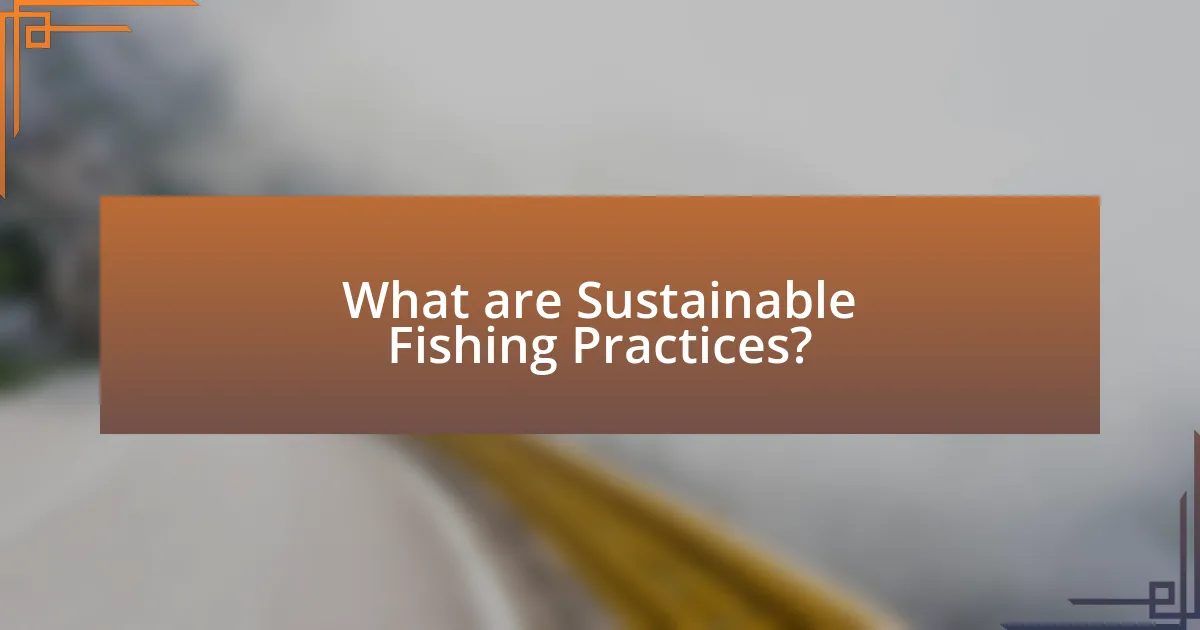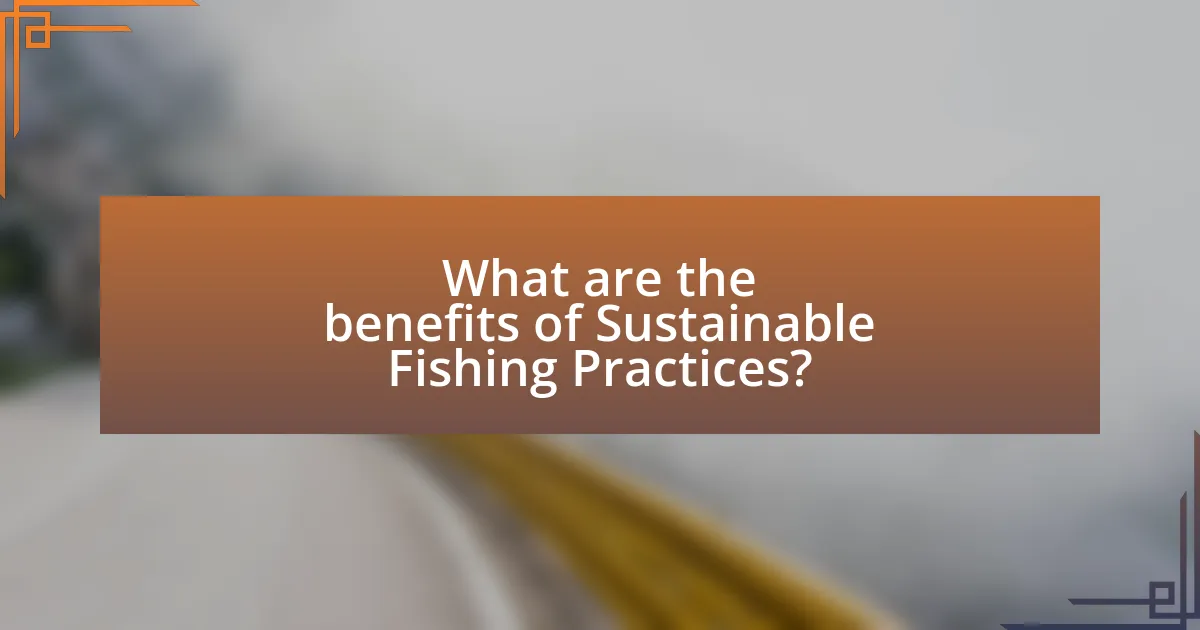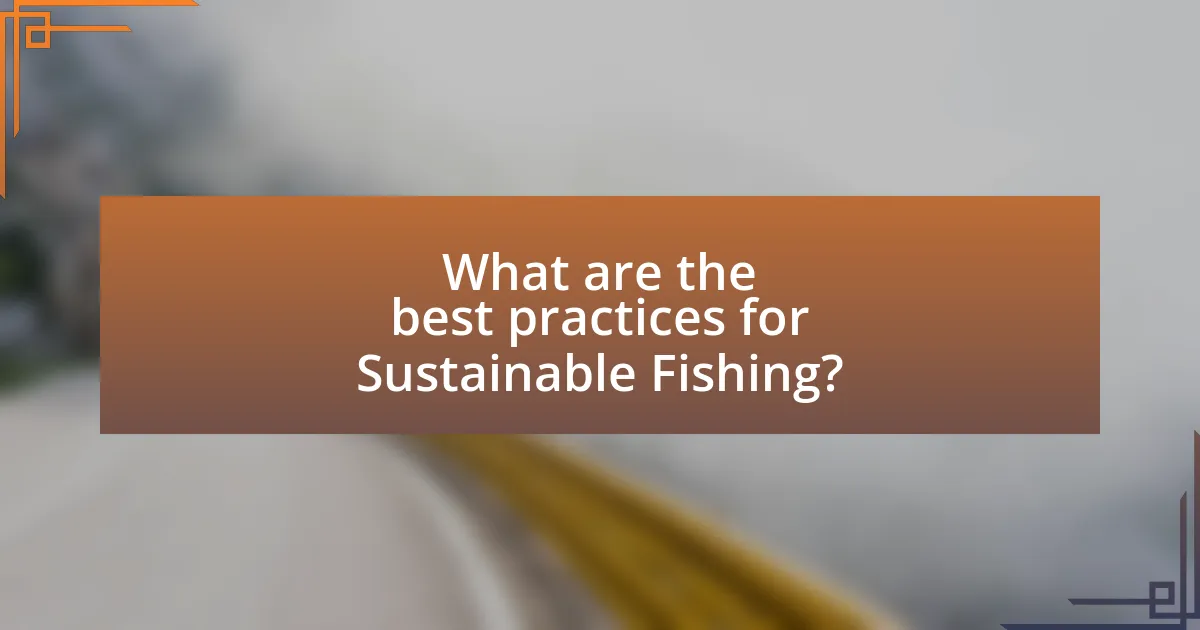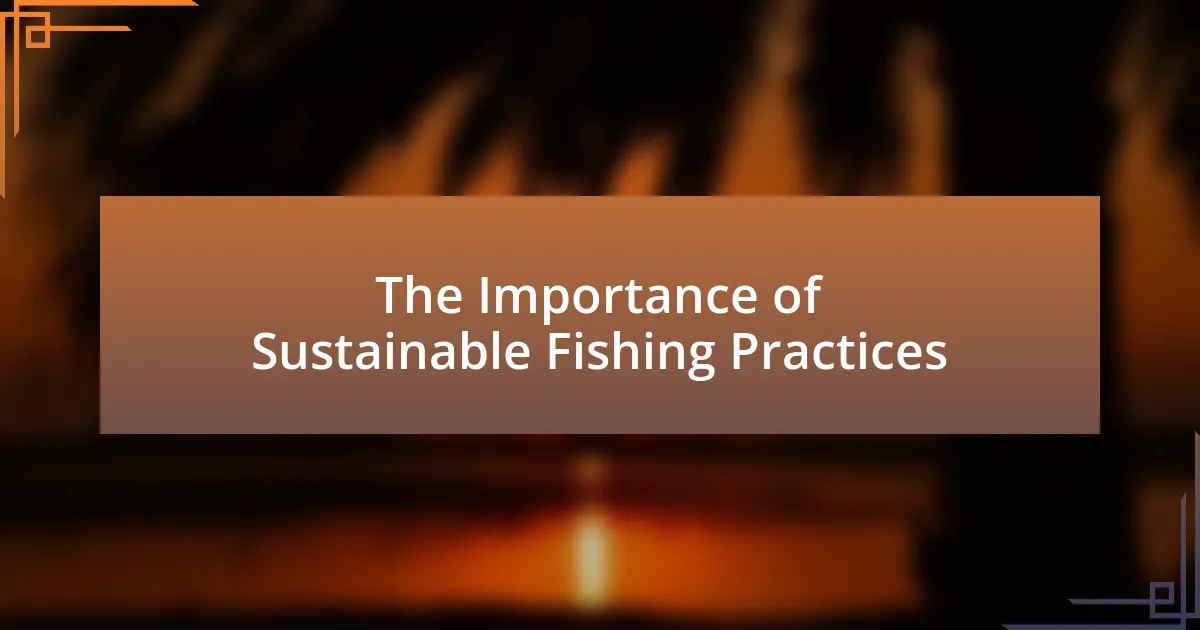Sustainable fishing practices are essential methods aimed at maintaining fish populations and marine ecosystems while minimizing environmental impact. This article outlines the significance of these practices in preventing overfishing, supporting biodiversity, and enhancing food security for coastal communities. It discusses the economic benefits for fishermen, the role of regulations and technology in promoting sustainability, and the importance of consumer choices in supporting responsible fishing. Key principles, challenges, and best practices for sustainable fishing are also examined, highlighting the collective responsibility of stakeholders in ensuring the long-term viability of fishery resources.

What are Sustainable Fishing Practices?
Sustainable fishing practices are methods of fishing that maintain fish populations and ecosystems while minimizing environmental impact. These practices include techniques such as catch limits, selective fishing gear, and seasonal closures to allow fish populations to recover. According to the Food and Agriculture Organization (FAO), sustainable fishing aims to ensure that fish stocks remain healthy and productive, which is essential for food security and the livelihoods of communities dependent on fishing. Implementing these practices helps prevent overfishing, protects marine habitats, and supports biodiversity, thereby contributing to the long-term viability of fishery resources.
Why are Sustainable Fishing Practices important for marine ecosystems?
Sustainable fishing practices are crucial for maintaining the health of marine ecosystems. These practices help prevent overfishing, which can lead to the depletion of fish populations and disrupt the balance of marine life. For instance, according to the Food and Agriculture Organization, approximately 34% of global fish stocks are overfished, which threatens biodiversity and the resilience of marine habitats. By implementing sustainable methods, such as catch limits and selective fishing gear, ecosystems can recover and thrive, ensuring the long-term viability of both fish populations and the overall marine environment.
How do Sustainable Fishing Practices contribute to biodiversity conservation?
Sustainable fishing practices contribute to biodiversity conservation by ensuring that fish populations remain healthy and ecosystems are preserved. These practices, such as catch limits, selective fishing gear, and habitat protection, help maintain the balance of marine ecosystems, preventing overfishing and allowing species to thrive. For instance, the implementation of marine protected areas has been shown to increase fish biomass and diversity, as evidenced by a study published in “Nature” by Edgar et al. (2014), which found that marine reserves can lead to a 446% increase in fish biomass compared to unprotected areas. By promoting the recovery of overexploited species and protecting critical habitats, sustainable fishing practices play a vital role in maintaining marine biodiversity.
What role do Sustainable Fishing Practices play in preventing overfishing?
Sustainable fishing practices play a crucial role in preventing overfishing by ensuring that fish populations are harvested at a rate that allows them to replenish. These practices include setting catch limits based on scientific assessments, using selective fishing gear to minimize bycatch, and protecting critical habitats. For instance, the implementation of the Magnuson-Stevens Fishery Conservation and Management Act in the United States has led to the recovery of several fish stocks by enforcing sustainable quotas and habitat protections. This evidence demonstrates that sustainable fishing practices are effective in maintaining fish populations and ecosystems, thereby preventing overfishing.
How do Sustainable Fishing Practices impact local communities?
Sustainable fishing practices positively impact local communities by promoting economic stability and environmental health. These practices ensure that fish populations remain abundant, which supports local fisheries and provides a reliable source of income for fishermen. For instance, a study by the World Bank found that sustainable fisheries can increase fish stocks by up to 30%, leading to higher catches and improved livelihoods for fishing communities. Additionally, sustainable practices help maintain the health of marine ecosystems, which is crucial for the long-term viability of local fisheries and the overall well-being of communities that rely on them for food and employment.
What economic benefits do Sustainable Fishing Practices provide to fishermen?
Sustainable fishing practices provide economic benefits to fishermen by ensuring long-term fish stock viability, which leads to stable income and job security. By adopting methods that prevent overfishing and protect marine ecosystems, fishermen can maintain consistent catch levels, reducing the risk of market fluctuations caused by depleted resources. For instance, a study by the World Bank indicated that sustainable fisheries can increase profits by up to 30% compared to conventional practices, as healthier fish populations lead to higher yields over time. Additionally, sustainable practices often open access to premium markets that prioritize eco-friendly products, allowing fishermen to command higher prices for their catch.
How do Sustainable Fishing Practices enhance food security for coastal populations?
Sustainable fishing practices enhance food security for coastal populations by ensuring the long-term availability of fish stocks, which are a primary source of protein and income for these communities. By implementing measures such as catch limits, seasonal closures, and habitat protection, sustainable practices prevent overfishing and promote the recovery of fish populations. For instance, the Food and Agriculture Organization (FAO) reports that sustainable fisheries can increase fish yields by up to 30%, thereby providing a more stable food supply. Additionally, these practices support ecosystem health, which is crucial for maintaining biodiversity and the resilience of marine environments, further securing food resources for future generations.
What are the key principles of Sustainable Fishing Practices?
The key principles of sustainable fishing practices include maintaining fish populations at healthy levels, minimizing environmental impact, and ensuring the livelihoods of fishing communities. Healthy fish populations are crucial for ecosystem balance; overfishing can lead to population collapse, as evidenced by the decline of cod stocks in the North Atlantic. Minimizing environmental impact involves using methods that reduce bycatch and habitat destruction, such as selective fishing gear and marine protected areas. Additionally, sustainable practices support the economic viability of fishing communities by promoting fair trade and responsible management, which is essential for long-term food security and economic stability.
How do regulations and policies support Sustainable Fishing Practices?
Regulations and policies support sustainable fishing practices by establishing legal frameworks that limit overfishing, protect marine ecosystems, and promote responsible resource management. For instance, quotas are set to control the amount of fish that can be caught, ensuring that fish populations remain healthy and can reproduce effectively. Additionally, policies often include measures such as marine protected areas, which safeguard critical habitats from destructive fishing practices, thereby enhancing biodiversity. Evidence of the effectiveness of these regulations can be seen in regions where catch limits and seasonal closures have led to the recovery of fish stocks, such as the North Sea cod, which has shown signs of population increase due to stringent fishing regulations implemented by the European Union.
What technologies are used to promote Sustainable Fishing Practices?
Technologies used to promote sustainable fishing practices include satellite tracking, electronic monitoring systems, and selective fishing gear. Satellite tracking allows for real-time monitoring of fishing vessels, ensuring compliance with regulations and reducing overfishing by providing data on fish populations and migration patterns. Electronic monitoring systems utilize cameras and sensors to collect data on catch composition and bycatch, which helps in assessing the impact of fishing activities on marine ecosystems. Selective fishing gear, such as circle hooks and fish traps, minimizes bycatch and targets specific species, thereby promoting the sustainability of fish stocks. These technologies collectively contribute to more responsible fishing practices and the preservation of marine biodiversity.
How can we transition to more Sustainable Fishing Practices?
To transition to more sustainable fishing practices, it is essential to implement stricter regulations on catch limits and promote the use of selective fishing gear. Stricter regulations help prevent overfishing by ensuring that fish populations remain at sustainable levels, as evidenced by the fact that regions with enforced catch limits have seen fish stocks recover significantly, such as the North Sea cod, which has shown signs of recovery since the introduction of quotas. Additionally, promoting selective fishing gear reduces bycatch, which is the unintentional capture of non-target species, thereby preserving marine biodiversity. Studies indicate that using gear designed to minimize bycatch can lead to a 50% reduction in unwanted catches, supporting healthier ecosystems.
What challenges do we face in implementing Sustainable Fishing Practices?
Implementing sustainable fishing practices faces several challenges, including overfishing, lack of regulatory enforcement, and economic pressures on fishing communities. Overfishing depletes fish stocks faster than they can replenish, leading to ecological imbalances. A study by the Food and Agriculture Organization (FAO) reported that approximately 34% of global fish stocks are overfished, highlighting the urgency of this issue. Additionally, many regions lack effective enforcement of fishing regulations, allowing illegal, unreported, and unregulated (IUU) fishing to thrive, which undermines sustainability efforts. Economic pressures, such as the demand for cheap seafood and the livelihoods of fishermen, often conflict with the adoption of sustainable practices, making it difficult to shift towards more responsible fishing methods.

What are the benefits of Sustainable Fishing Practices?
Sustainable fishing practices provide numerous benefits, including the preservation of fish populations and marine ecosystems. By implementing methods that minimize overfishing and habitat destruction, sustainable practices ensure that fish stocks remain healthy and can reproduce effectively. For instance, according to the Food and Agriculture Organization (FAO), sustainable fishing can lead to a 20% increase in fish populations over time, which supports biodiversity and ecosystem stability. Additionally, these practices contribute to the long-term viability of fishing communities by securing livelihoods and promoting economic resilience. Research indicates that sustainable fisheries can generate up to 50% more revenue compared to conventional fishing methods, highlighting their economic advantages.
How do Sustainable Fishing Practices benefit the environment?
Sustainable fishing practices benefit the environment by promoting the health of marine ecosystems and ensuring the long-term viability of fish populations. These practices reduce overfishing, which can lead to the depletion of species and disruption of food chains. For instance, according to the Food and Agriculture Organization, sustainable fishing methods help maintain biodiversity by allowing fish stocks to replenish and supporting the overall balance of marine life. Additionally, sustainable practices often involve minimizing bycatch and habitat destruction, which further protects marine habitats and the species that rely on them.
What are the long-term ecological advantages of adopting Sustainable Fishing Practices?
Adopting sustainable fishing practices leads to long-term ecological advantages such as the preservation of fish populations and the maintenance of marine biodiversity. These practices ensure that fish stocks are harvested at a rate that allows them to replenish, preventing overfishing, which has been shown to deplete species and disrupt ecosystems. For instance, the implementation of catch limits and protected marine areas has resulted in a 20% increase in fish populations in regions where these measures are enforced, according to a study published in the journal “Nature” by Worm et al. (2009). Additionally, sustainable practices reduce bycatch, which protects non-target species and helps maintain the balance of marine ecosystems. This holistic approach not only supports the health of the oceans but also contributes to the resilience of marine environments against climate change impacts.
How do Sustainable Fishing Practices help in restoring fish populations?
Sustainable fishing practices help restore fish populations by implementing measures that prevent overfishing and protect marine ecosystems. These practices include setting catch limits based on scientific assessments, using selective fishing gear to minimize bycatch, and establishing marine protected areas where fishing is restricted or prohibited. For example, the implementation of catch shares in fisheries has been shown to lead to a 20% increase in fish stocks over a decade, as reported by the National Oceanic and Atmospheric Administration. By ensuring that fish populations are harvested at sustainable levels, these practices promote the recovery of depleted species and contribute to the overall health of marine environments.
What social benefits arise from Sustainable Fishing Practices?
Sustainable fishing practices provide significant social benefits, including improved community livelihoods and enhanced food security. By ensuring fish populations remain healthy, these practices support local economies that depend on fishing, leading to stable jobs and income for fishermen and their families. Furthermore, sustainable fishing contributes to food security by maintaining fish stocks, which are a vital source of protein for millions of people globally. Research indicates that sustainable fisheries can increase community resilience, as seen in regions where fishery management has led to a 20% increase in local fish populations, directly benefiting local communities through better access to resources and economic stability.
How do Sustainable Fishing Practices promote community engagement?
Sustainable fishing practices promote community engagement by fostering collaboration among local fishers, conservationists, and community members to manage resources responsibly. These practices often involve community-based management systems, where stakeholders participate in decision-making processes, leading to a shared sense of ownership and responsibility for marine ecosystems. For example, initiatives like co-management agreements have been shown to enhance local participation, resulting in improved fish stocks and community well-being, as evidenced by studies conducted in various coastal regions. This collaborative approach not only strengthens community ties but also empowers individuals to advocate for sustainable practices, thereby reinforcing the social fabric and economic resilience of fishing communities.
What educational opportunities do Sustainable Fishing Practices create?
Sustainable fishing practices create educational opportunities by promoting awareness of marine ecosystems and responsible resource management. These practices encourage the development of programs that teach communities about the ecological impacts of overfishing and the importance of biodiversity. For instance, initiatives like community workshops and school curricula focused on sustainable fishing methods provide hands-on learning experiences. Research indicates that educational programs in sustainable fishing can lead to increased knowledge and engagement, as seen in studies conducted by the Food and Agriculture Organization, which highlight the effectiveness of education in fostering sustainable practices among fishers and consumers alike.
How do Sustainable Fishing Practices contribute to economic resilience?
Sustainable fishing practices contribute to economic resilience by ensuring the long-term viability of fish stocks and the communities that depend on them. These practices, such as catch limits and habitat protection, help maintain fish populations at sustainable levels, which in turn supports stable incomes for fishermen and related industries. For instance, a study by the World Bank found that sustainable fisheries can increase fish stocks by up to 50%, leading to higher yields and economic stability for coastal communities. By promoting biodiversity and ecosystem health, sustainable fishing also mitigates the risks associated with overfishing and environmental degradation, further enhancing economic resilience in the fishing sector.
What are the financial implications of adopting Sustainable Fishing Practices for fisheries?
Adopting sustainable fishing practices leads to long-term financial benefits for fisheries by ensuring the health of fish stocks and ecosystems. Sustainable practices reduce overfishing, which can deplete resources and lead to economic losses; for instance, the World Bank estimates that sustainable fisheries could generate an additional $50 billion annually by 2030. Furthermore, sustainable practices can enhance market access and consumer demand, as there is a growing preference for responsibly sourced seafood. Research from the Food and Agriculture Organization indicates that fisheries adopting sustainable practices experience increased profitability and resilience against market fluctuations.
How do Sustainable Fishing Practices influence market demand for seafood?
Sustainable fishing practices significantly increase market demand for seafood by aligning consumer preferences with environmental responsibility. As consumers become more aware of overfishing and its ecological impacts, they increasingly seek seafood sourced from sustainable fisheries. Research indicates that 66% of consumers are willing to pay more for sustainably sourced seafood, reflecting a growing trend towards ethical consumption. This shift in consumer behavior drives retailers and suppliers to prioritize sustainable practices, thereby enhancing market demand for seafood that meets these criteria.

What are the best practices for Sustainable Fishing?
The best practices for sustainable fishing include implementing catch limits, using selective fishing gear, and protecting marine habitats. Catch limits ensure that fish populations remain healthy by preventing overfishing; for example, the International Council for the Exploration of the Sea recommends specific quotas based on scientific assessments. Selective fishing gear, such as circle hooks and fish traps, minimizes bycatch, which is the capture of unintended species, thereby preserving biodiversity. Additionally, protecting marine habitats through the establishment of marine protected areas helps maintain ecosystem balance and supports fish populations. These practices are supported by various studies, including the Food and Agriculture Organization’s report on sustainable fisheries, which emphasizes the need for responsible management to ensure long-term viability of fish stocks.
How can fishermen adopt Sustainable Fishing Practices effectively?
Fishermen can adopt sustainable fishing practices effectively by implementing catch limits, using selective gear, and participating in community management initiatives. Catch limits help prevent overfishing by ensuring that fish populations remain healthy and can reproduce. For example, the implementation of Total Allowable Catches (TACs) in various fisheries has shown to stabilize fish stocks. Selective gear, such as circle hooks and fish traps, reduces bycatch and minimizes harm to non-target species, which is crucial for maintaining biodiversity. Additionally, engaging in community management initiatives fosters local stewardship and enhances compliance with sustainable practices, as seen in successful co-management models in places like Alaska. These strategies collectively contribute to the long-term viability of fish stocks and marine ecosystems.
What training and resources are available for fishermen to learn about Sustainable Fishing Practices?
Fishermen can access various training programs and resources to learn about sustainable fishing practices, including workshops, online courses, and certification programs. Organizations such as the Marine Stewardship Council (MSC) and the World Wildlife Fund (WWF) offer educational materials and training sessions focused on sustainable fishing techniques and ecosystem management. Additionally, government agencies often provide resources, such as guidelines and best practices, to promote sustainable fishing. For example, the National Oceanic and Atmospheric Administration (NOAA) offers training programs that emphasize sustainable fisheries management and conservation strategies. These resources are designed to enhance fishermen’s knowledge and skills, ensuring they can implement sustainable practices effectively.
How can technology aid in the implementation of Sustainable Fishing Practices?
Technology aids in the implementation of sustainable fishing practices by providing tools for monitoring fish populations, optimizing fishing methods, and enhancing data collection. For instance, satellite tracking and sonar technology allow fishery managers to monitor fish stocks in real-time, ensuring that fishing quotas are based on accurate data. Additionally, innovations such as automated fishing gear and selective fishing techniques reduce bycatch and minimize environmental impact. Research from the Food and Agriculture Organization indicates that the use of technology in fisheries management can lead to a 20% increase in sustainable yields, demonstrating its effectiveness in promoting responsible fishing practices.
What role do consumers play in promoting Sustainable Fishing Practices?
Consumers play a crucial role in promoting sustainable fishing practices by influencing market demand for responsibly sourced seafood. When consumers choose to purchase products certified by organizations such as the Marine Stewardship Council, they signal to suppliers and fisheries the importance of sustainable practices. According to a 2021 study published in the journal “Marine Policy,” consumer awareness and preference for sustainable seafood can lead to increased sales of certified products, thereby encouraging fisheries to adopt environmentally friendly methods. This shift in consumer behavior not only supports sustainable fishing but also helps protect marine ecosystems and ensures the long-term viability of fish populations.
How can consumers make informed choices to support Sustainable Fishing Practices?
Consumers can make informed choices to support sustainable fishing practices by selecting seafood that is certified by reputable organizations such as the Marine Stewardship Council (MSC) or the Aquaculture Stewardship Council (ASC). These certifications indicate that the seafood is sourced from fisheries or farms that adhere to environmentally responsible practices. Research shows that sustainable fishing practices help maintain fish populations and protect marine ecosystems, which is crucial for long-term food security and biodiversity. Additionally, consumers can utilize resources like the Seafood Watch program, which provides recommendations on sustainable seafood choices based on the latest scientific data. By prioritizing certified and recommended seafood, consumers actively contribute to the preservation of marine resources and promote responsible fishing practices.
What certifications should consumers look for when purchasing seafood?
Consumers should look for certifications such as the Marine Stewardship Council (MSC), Aquaculture Stewardship Council (ASC), and the Global Aquaculture Alliance’s Best Aquaculture Practices (BAP) when purchasing seafood. These certifications indicate that the seafood has been sourced sustainably, adhering to environmental and social responsibility standards. For instance, the MSC certification ensures that wild-caught seafood comes from fisheries that are well-managed and sustainable, while the ASC certification focuses on responsible aquaculture practices. The BAP certification covers various aspects of aquaculture, including environmental sustainability, social responsibility, and food safety. These certifications help consumers make informed choices that support sustainable fishing practices.
What are some practical tips for supporting Sustainable Fishing Practices?
To support sustainable fishing practices, individuals can choose seafood certified by reputable organizations like the Marine Stewardship Council, which ensures that fish are sourced from well-managed fisheries. Additionally, consumers should educate themselves about local fish populations and avoid overfished species, as highlighted by the Food and Agriculture Organization, which reports that approximately 34% of global fish stocks are overfished. Engaging in community-supported fisheries can also promote local economies and sustainable practices, as these initiatives often prioritize environmentally friendly methods. Lastly, advocating for policies that protect marine habitats and support sustainable fishing regulations can further enhance the effectiveness of these practices.
